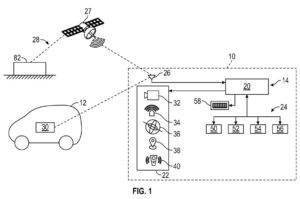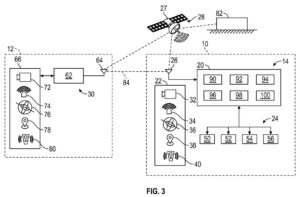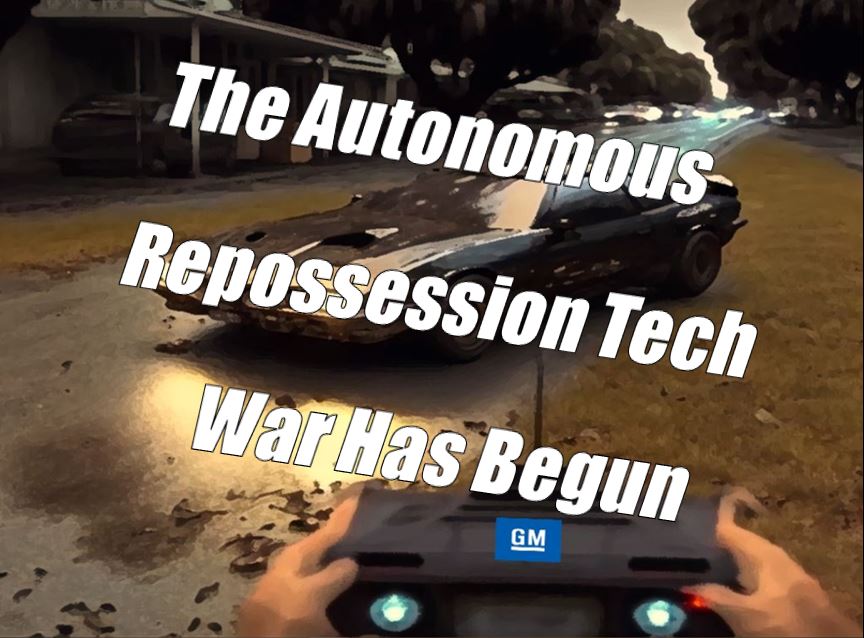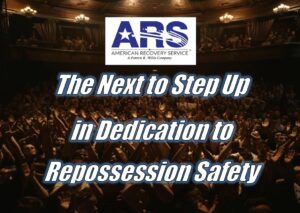The Autonomous Repossession Technology Battle Has Begun
It looks like GM is taking a stab at similar remote repossession process as Ford. Although titled, functioning slightly different than and described as a different purpose as a means to lead another vehicle autonomously to a set destination, there is little doubt that it has a secondary application the same as Ford’s should it be desired; remote repossessions.
First reported in GMAuthority.com, General Motors (GM) has applied for a patent the new remote autonomous vehicle (AV) towing system on March 16th, 2023. Assigned patent number 2023/0082897 A1, the United States Patent and Trademark Office (USPTO) credits the inventors as GM’s Global Technology Operations engineers team based in Michigan, Arun Adiththan, Rasoul Salehi, Yao Hu and Yilu Zhang.
See The Patent Here!
The disclosure in the Introduction states “the present disclosure relates to an autonomous vehicle that is guided by a towing taxi in the event an autonomous driving system is non-functional.” One needs only replace the word “taxi” with “vehicle” and replace the phrase “driving system is non-functional” with “vehicle requires repossession” to see its dual purpose.

The primary difference between the two processes, is that Ford’s is managed from a distant location, while GM’s is operated from a towing taxi, as they put it. In other words, Ford drives them and GM tows them. The timing of the patent’s final filing following Ford’s Self-Repossessing Vehicles Patent earlier this month may be more than coincidental.
Hacking the System
GM’s new patent, originally filed in September 10 of 2021, describes a system to autonomously tow a non-functioning autonomous system with a functioning drive system by means of a wireless second autonomous vehicle.
While making no statement of intention of a repossession purpose, it’s not hard to see a secondary use for this technology. GM’s patent states that in AV’s, issues could arise in its autonomous systems, such as hardware problems with the sensor array, or software problems with the onboard algorithms that render the AV inoperable for self-driving. In short, brain dead.
And while the propulsion and chassis systems, may be functional, the lack of functionality in the autonomous systems (brain) could leave the vehicle dead in the water.
GM’s solutions is to enable a secondary vehicle, autonomous in description, although it could be and most likely would be manned, to hack into the AV and override its inoperable autonomous systems (brain.) This method would allow the secondary vehicle, or operator, to gain access to the still functional propulsion and chassis systems.

Through this wireless overriding (hacking) of the inoperable portion of the AV and commandeering of the functioning portions, the AV could then be guided to a desired destination leaving the necessity of a tow truck or driver unnecessary.
Who is Going to Do the Driving?
There are many safety and privacy issues to explore with this process, but let’s just suppose this was to be implemented. Who is going to be the one to drive these vehicles? Certainly, they don’t expect AI to manage it all front to back. Humans will still be needed no matter the purpose. Unless civilization comes to a level of trust in AI that is decades ahead of where it is, and God save us if it does, there will always be the need for a human operator.
Would GM want to staff up a wing of their operations to pilot and manage these situations and put boots on the ground to set human eyes on the process? Not likely due to the vast network needed to execute the process all across the nation.
As far as repossession use goes, I again state that the risk of litigation that could stem from their hands-on employment of these practices is huge and there are solid reasons why lenders quit performing their own repossessions decades ago. Too many lawsuits, too many employees getting killed.
Repossession Agencies and Tow Companies
For its stated intended purposes, hypothetically, tow companies could be the likely candidates to utilize this process and technology. But at what cost? The hardware and training to take it to market would have to be built into the tow costs and would explode the already high tow fees.
If used to repossess, the same issue of expense exists. Lets face it, if lenders don’t want to pay dolly or flat bed fees, does it seem likely that they’ll be willing to drop $1,000 or more on top of a repossession fee no matter how low?
Unless by the time such technology rolls out, the repossession industry hasn’t weeded out the numerous small and unqualified agencies across the nation, it could get deadly. In the wrong hands, it’s like giving a monkey a machine gun.
Not in This World

Going back to the arguments I made against Ford’s “Self-Repossessing Vehicles Patent” earlier this month, while the technology may hypothetically exist, we don’t currently live in a world that’s ready for it. Lawyers and politicians already have enough trouble with the use of GPS, auto interruption devices and LPR. They are a long way from accepting this.
One of its inventors at GM’s Global Technology Operations, Senior Researcher, Arun Adiththan, has also filed patents for autonomous fleet control systems for vehicles using similar processes. Using terms like “Platoon” and leader, they more resemble a system for robotic warfare than for any civilian use, but autonomous vehicle control appears to be high on GM’s to do list.
Once again, these are all exciting concepts. But the idea that at any point soon, technology could be used to completely cut out the human element of towing or repossessing from a remote headquarters office full of tech savvy remote agents is a million miles away.
Going back to the cost of conducting such a service there is no way that GM could price model this for outsourcing for a reasonable cost to the public. There would be hardware expenses, insurance and training required that would probably exceed its practical implementation.
And suppose they did launch this rocket, where are they going to store these vehicles, at dealerships or are they going invest in their own satellite storage lots to store them at? Who is going to inventory and remove the garbage bags full of personal property and deal with the pesky humans and all of their variable issues?
No, that’s still a million miles and decades away. It would still require trained humans.
Demotion Man
Life imitates art. Just take a peek at the 93’ film Demolition Man with Sylvester Stallone. In the film, our hero, John Spartan, a wrongfully convicted cop, is unfrozen from a cryogenic prison in the year 2032 and sent after an escaped criminal. It’s a world where vegetarianism is the norm, cussing is outlawed, Taco Bell is the only restaurant and self-driving cars are the norm.
This film is only set ten years from now. I guess we should start learning how to use the three sea shells, because it’s starting to look like that’s where we’re heading.
Now, with all of my ranting on the topic, I’ll just leave this here. Perhaps in ten to twenty years this article will be laughed at and ridiculed like some late 19th century newspaper editorial on how automobiles will never replace horses. What the hell do I know about the future? With all of the things I’ve seen in the past three years, it’s getting hard to rule anything out.
Kevin Armstrong
Publisher
















Facebook Comments